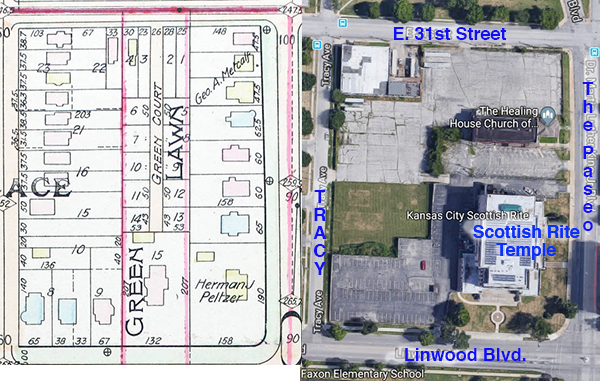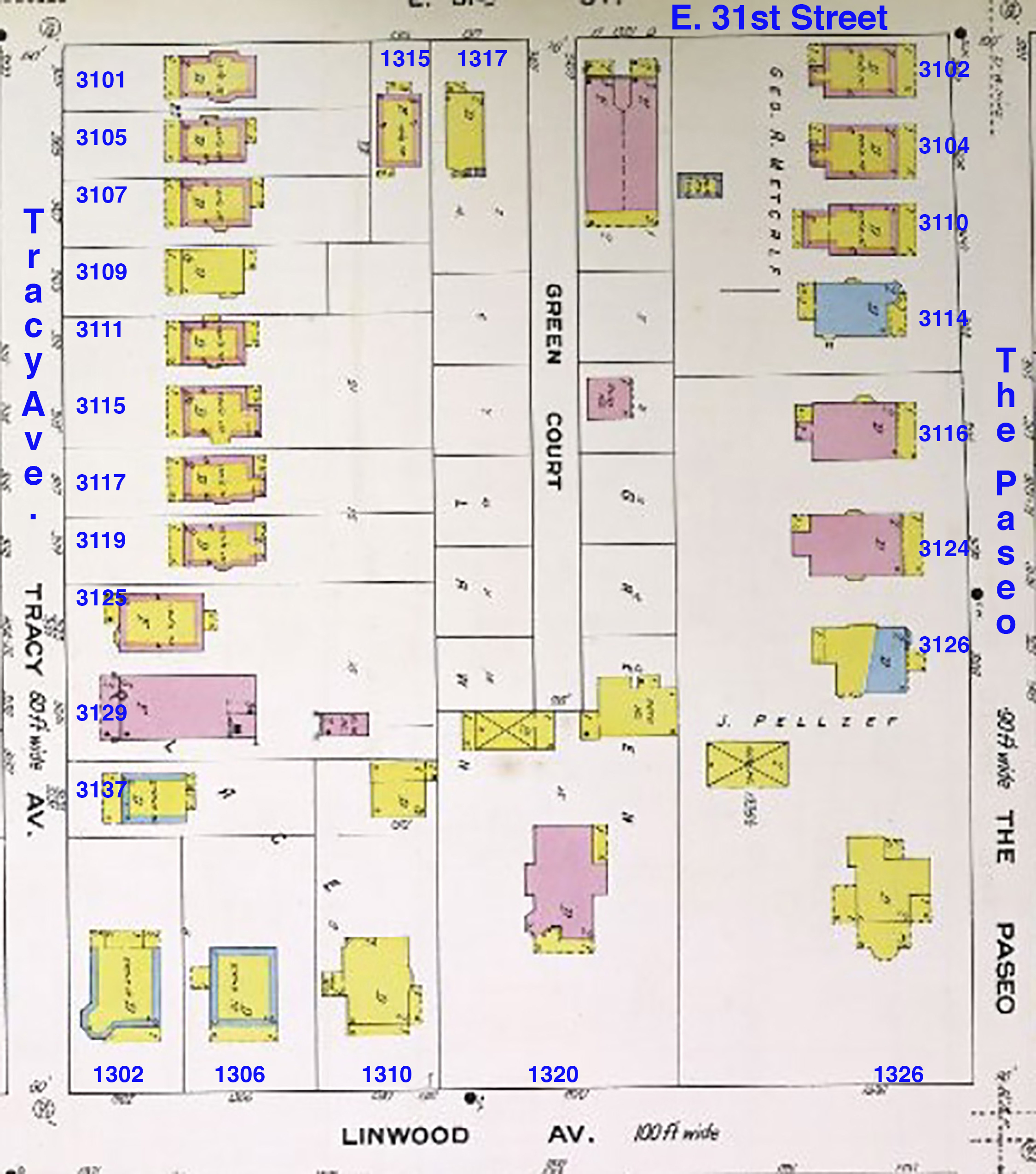
This block, bounded by Tracy to the west, The Paseo to the east, E. 31st to the north and Linwood Boulevard to the south, began as a well-to-do residential block in 1900. Seen above in a 1907 map (left), the large Peltzer home dominated the important corner of Linwood and The Paseo. Over the following decades, the large old homes became boarding and apartment houses and were replaced by nonresidential buildings. Today, the recent Google map on the right shows the Scottish Rite Temple, begun in 1928, as the major tenant.
If location is all-important in real estate, location along two boulevards must be even better. The intersection of Linwood Boulevard and The Paseo (now called Martin Luther King, Jr. Boulevard) historically attracted elite families, who moved into substantial homes before the turn of the 20th century. But the location also made the block a target for commercial and institutional developers in the 192os.
This week’s featured block, from The Paseo (now called Martin Luther King, Jr. Boulevard) and Tracy between 31st Street and Linwood Boulevard, follows a familiar pattern across Midtown. From the 1880s to 1900, wealthy families moved south, spreading out along the newly-created boulevards and often building mansions meant to last a century. But by the 1920s, many residents had also moved south and they needed not only housing, but new churches, schools, businesses and institutions. Major streets such as The Paseo and Linwood naturally became the setting for these, and even relatively new homes along these key sites were often replaced by larger buildings.
As part of our Uncovering History Project, the Midtown KC Post is taking a look at each block in Midtown, including a set of 1940 tax assessment photos which is available for many blocks. Unfortunately, the Kansas City Public Library does not have the 1940s photos from the block of The Paseo and Tracy between 31st Street and Linwood Boulevard. For more about the Scottish Rite temple, see an earlier post.
In 1900, a Block of Well-Off Families
The Cowherd Company, which built many homes in Midtown, began selling new homes on the block in the late 1890s. The 1900 census shows well-off families had settled in, dominated by the large Peltzer home at the corner of Linwood and the Paseo. Theodore Peltzer, 62, was listed as a brick manufacturer. He shared the large home with his wife Gertrude, 45, two sons and a daughter. The census offers this snapshot of the neighbors on the block:
- 1310 Linwood: John Phillips, 65, lawyer; wife Fleecie, 66; daughter Hortence Feble, 35; son-in-law M. William Feble; granddaughter Helen Feble, 3; grandson F. John Feble, 7; black servant William Norman, 25; and white servant Dell Stimpson, 24.
- 1302 Linwood: James Fletcher,51, railroad manager; wife Ella, 50; daughter Eloise, 21; son Charles, 18; daughter Abbie, 15; sister-in-law Mary Talbott, 58, widowed.
- 3119 Tracy: Felix Kander, 56, lawyer; wife Matilda, 41; daughter Alice, 17; daughter Ruth, 15; son Harold, 14; son Allen, 10; black servant W. Sally Tuele, 25.
- 3117 Tracy:Eli Minerath, 40, merchandise broker; wife Bell, 34; son S. Irving, 8; daughter Lucile, 5; black servant Julia Henry, 24.
- 3115 Tracy: Samuel Cook, 43, hay dealer; wife Estella, 43; daughter Josephine, 2; white servant Mabelle McCulley, 19.
- 3111 Tracy:John Nuchols, 73, retired; wife Annie, 67; daughter Mrs. Howard McCreary, 46, widowed; black servant Cornelia Wilson, 25. Also C. C. Hoyt, 47, a real estate man; wife Cara, 41; daughter L. Minnie, 17; son M. Sherman, 11; son Caron, 8; son George, 6.
- 3105 Tracy: Lee Campbell, 44, a commercial traveler; wife Marvell, 41; son W. Lee, 13; daughter L. Mary, 11; daughter Lorena, 7; black servant Cornelia Alexander, 44.
- 3113 Tracy: William Archer, 39; wife Alice, 33; son L. William, 11; son R. Virgil, 10; daughter E. Madalene, 8.
- 1315 E.31st: George Ogden, 45, coal merchant; wife L. Alice, 43; son Ralph, 19; daughter L. Olive, 17; daughter M. Helen, 14.
- 1317 E.31st: Jarvey Cannon, 49, mail carrier; wife Mary, 27; son C. James, 6; son John, 6; daughter Mary, 4; son Justine, 1.
- 1320 Linwood:Thomas Green, 63, grocer; wife Bridget, 57; daughter Elizabeth, 29; daughter Ellen, 27; son B. Thomas, 25, salesman; son M. James, 23, salesman; son W. Francis, 20, clerk; daughter C. Bernice, 19; black servant Hannah Hughes, 23; black servant Homer Davis, 17.
Changes Over the Decades
By 1915, the Peltzer family had moved on, selling the corner lot at Linwood and The Paseo. It was briefly considered as an ideal site for an 11-story apartment building, part of a wave of luxury apartment hotels springing up across city boulevards. When Julius Davidson bought it in 1915, arts advocates tried to convince him it would be the perfect location for a music hall. In 1928, the Scottish Rite began construction of its new building, which still stands today.
As Kansas City’s population multiplied, many of the large older homes on the block were made into apartment or rooming houses as early as the late 1920s. In 1923, The United Brotherhood of Carpenters and Joiners, the largest union in Kansas City, bought the 10-room stone residence at 3114 Paseo and erected a new Carpenters Hall behind it. A chiropractor bought the building next door in 1940 and remodeled it as office space. In 1939, Mrs. Nettie Shockley was arrested in a raid, fined for keeping a disorderly house and selling liquor without a city license at 1302 Linwood, perhaps signaling the decline of the block.
Historic photos courtesy Kansas City Public Library/Missouri Valley Special Collections.
Do you have memories or more details about this area of Midtown? Please share them with our readers. Would you like us to focus on your block next week? Send us an email.
Our book, Kansas City’s Historic Midtown Neighborhoods, is available now at local bookstores and on Amazon.com. Let us know if you want us to come to your neighborhood association or organization’s meeting to share what we’ve learned about Midtown neighborhood history and tell your members how they can help preserve Midtown history.




Hi.
Do you have and pictures of Michigan Ave from 41st through 44th?